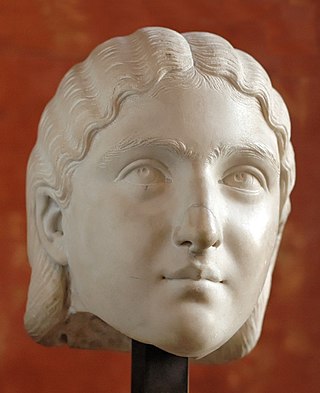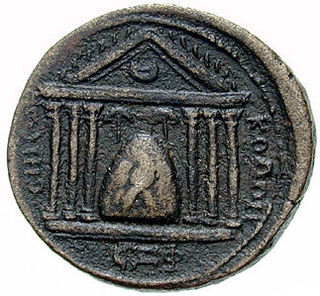Related Research Articles

Marcus Aurelius Severus Alexander, also known as Alexander Severus, was Roman emperor from 222 until 235. The last emperor from the Severan dynasty, he succeeded his slain cousin Elagabalus in 222, at the age of 13. Alexander himself was eventually assassinated, and his death marked the beginning of the events of the Crisis of the Third Century, which included nearly fifty years of civil war, foreign invasion, and the collapse of the monetary economy.

Marcus Aurelius Antoninus, better known by his posthumous nicknames Elagabalus and Heliogabalus, was Roman emperor from 218 to 222, while he was still a teenager. His short reign was notorious for religious controversy and alleged sexual debauchery. A close relative to the Severan dynasty, he came from a prominent Syrian Arab family in Emesa (Homs), Syria, where he served as the head priest of the sun god Elagabal from a young age. After the death of his cousin, the emperor Caracalla, Elagabalus was raised to the principate at 14 years of age in an army revolt instigated by his grandmother Julia Maesa against Caracalla's short-lived successor, Macrinus. He only posthumously became known by the Latinised name of his god.

Lucius Septimius Severus was Roman emperor from 193 to 211. He was born in Leptis Magna in the Roman province of Africa. As a young man he advanced through the customary succession of offices under the reigns of Marcus Aurelius and Commodus. Severus was the final contender to seize power after the death of the emperor Pertinax in 193 during the Year of the Five Emperors.

The Severan dynasty, sometimes called the Septimian dynasty, was an Ancient Roman imperial dynasty that ruled the Roman Empire between 193 and 235, during the Roman imperial period. The dynasty was founded by the emperor Septimius Severus, who rose to power after the Year of the Five Emperors as the victor of the civil war of 193–197, and his wife, Julia Domna. After the short reigns and assassinations of their two sons, Caracalla and Geta, who succeeded their father in the government of the empire, Julia Domna's relatives themselves assumed power by raising Elagabalus and then Severus Alexander to the imperial office.
Year 235 (CCXXXV) was a common year starting on Thursday of the Julian calendar. At the time, it was known as the Year of the Consulship of Severus and Quintianus. The denomination 235 for this year has been used since the early medieval period, when the Anno Domini calendar era became the prevalent method in Europe for naming years.
Sextus Varius Marcellus was a Roman aristocrat and politician from the province of Syria. He was father of the emperor Elagabalus.

Legio III Gallica was a legion of the Imperial Roman army. The cognomen Gallica suggests that its earliest recruits came from veterans of the Gallic legions of Gaius Julius Caesar, a supposition supported by its emblem, a bull, a symbol associated with Caesar. The legion was based for most of its existence at Raphanea, Roman Syria, and was still active in Egypt in the early 4th century.

Julia Domna was Roman empress from 193 to 211 as the wife of Emperor Septimius Severus. She was the first empress of the Severan dynasty. Domna was born in Emesa in Roman Syria to an Arab family of priests of the deity Elagabalus. In 187, she married Severus, who at the time was governor of the Roman province of Gallia Lugdunensis. They had two sons, Caracalla and Geta. A civil war over the Roman throne broke out in 193, and shortly afterwards Severus declared himself emperor. The war ended in 197 with the defeat of the last of Severus's opponents.

Julia Maesa was a member of the Severan dynasty of the Roman Empire who was the grandmother of emperors Elagabalus and Severus Alexander, elder sister of empress Julia Domna, and mother of Julia Soaemias and Julia Mamaea. She wielded influence during the reigns of her grandsons as Augusta of the Empire from 218 to her death, especially on their elevation to emperors.

Julia Soaemias Bassiana was a Syrian noblewoman and the mother of Roman emperor Elagabalus, who ruled over the Roman Empire from 218 to 222. She was one of his chief advisors, initially with the support and accompaniment of her mother Julia Maesa. She and her mother guided the young emperor until growing unrest and a family division led to her son's replacement by her nephew Severus Alexander. Julia Soaemias was killed along with her son by the Praetorian Guard.

Julia Avita Mamaea or Julia Mamaea was a Syrian noble woman and member of the Severan dynasty. She was the mother of Roman emperor Alexander Severus and remained one of his chief advisors throughout his reign. She was killed in 235 by rebel soldiers alongside her son.

The Emesenedynasty, also called the Sampsigeramids or the Sampsigerami or the House of Sampsigeramus, were a Roman client dynasty of Syrian priest-kings known to have ruled by 46 BC from Arethusa and later from Emesa, Syria, until between 72 and 78/79, or at the latest the reign of Emperor Antoninus Pius (138–161). Iamblichus, the famous Neoplatonist philosopher of the third century, was one of their descendants, as was empress Julia Domna, matriarch of the Severan dynasty.

Gnaea Seia Herennia Sallustia Barbia Orbiana, usually known as Sallustia Orbiana, was a third century Roman empress, with the title of Augusta as the wife of Severus Alexander from AD 225 to 227. The emperor married her in late 225, following the death of his grandmother. Severus was around sixteen years of age at this time. She was known for her beauty, which was captured in multiple works of art. Possibly a victim of the jealousy of Julia Mamaea, the emperor's mother, Orbiana was divorced and exiled to Libya in 227.

Julius Bassianus was an Arab high priest of Elagabalus at the Temple of the Sun in Emesa, Syria, where this solar deity was worshipped in a shape of a black stone. The name Elagabalus derives from Ilāh and gabal, resulting in "the God of the Mountain," the Emesene manifestation of the deity. Bassianus was a member of the Royal family of Emesa, which was a part of the Arab aristocracy in this client kingdom of the Roman Empire. The beginning of his priesthood is unknown, but by 187 he was a high priest at Emesa. Bassianus was a son of a Julius and his paternal uncle was Julius Agrippa, who served as a Primipilaris.
Gaius Julius Avitus Alexianus was a Roman nobleman of Syria who had an impressive military and political career.
Gaius Julius Sohaemus Philocaesar Philorhomaeus also known as Sohaemus of Emesa and Sohaemus of Sophene, was a prince and a Roman Client Priest King from Syria who lived in the 1st century. He ruled the Emesan kingdom from 54 until 73. His name may derive from the Aramaic root ŠḤM, which described the color black.
Gaius Julius Alexion was a Syrian Prince and Roman Client Priest King of Emesa. He was the son of Syrian king Sohaemus and Queen Consort Drusilla.
Marcus Julius Gessius Bassianus was a Magister (master) in the Arval Brethren during the reign of Roman emperor Caracalla who ruled from 212 until 217.

This article lists historical events that occurred between 201–300 in modern-day Lebanon or regarding its people.
References
- 1 2 3 4 5 Birley, Septimius Severus: The African Emperor, p. 222
- 1 2 3 4 "Julia Avita Mamaea's article at Livius.org". Archived from the original on 2014-11-23. Retrieved 2020-03-26.
- ↑ Alexander Severus (A.D. 222–235) - De Imperatoribus Romanis by H.W. Benario
- ↑ Robert Lee Cleve: Severus Alexander and the Severan Women, Los Angeles 1982, pp. 90.
- ↑ Birley, Septimius Severus: The African Emperor, pp. 217, 222
- ↑ Augustan History, The Two Maximini, 29